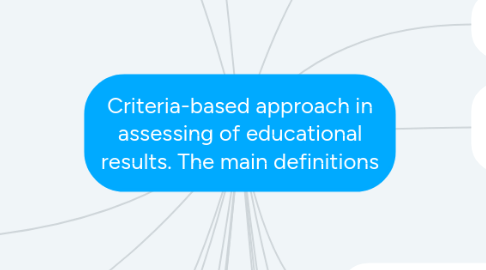
1. Quiz activities
2. Terms and definitions
2.1. Descriptor
2.2. Criteria-based assessment
2.3. Evalution criterion
2.4. Moderation
2.5. Feedback
2.6. Expected learning outcomes
2.7. Reflexion
2.8. Rubric
2.9. Summative assessment
2.10. Formative assessment
2.11. Teaching objectives
2.12. Electronic Journal Recording Assessment Results
3. Types of assessment in world education systev
3.1. Assessment in American schools
3.1.1. Formative assessment
3.1.2. Summative assessment
3.1.3. Observational assessment
3.1.4. Selected response
3.1.5. Constructed response
3.1.6. Portfolio assessment
3.1.7. Performance assessment
3.2. Assessment in British schools
3.2.1. Diagnostic assessment
3.2.2. Formative assessment
3.2.3. Summative assessment
3.2.4. Norm-Referenced assessment
3.2.5. Criterion-Referenced assessment
3.2.6. Interim\Benchmark assessment
3.3. Advantages & Disadvantages of traditional assessment
3.3.1. Definition and Alternatives
3.3.2. Ease of analysis
3.3.3. Lack of context
3.3.4. Impact on teaching
4. Types of criteria-based assessment
4.1. Formative assessment
4.2. Summative assessment
4.3. Multiple Choice assessment
4.4. Written short answer
4.5. Written long answer
4.6. Research projects
4.7. Verbal questioning
4.8. Observing practical work
4.9. Class test
5. Criteria-based asessment as means of educational motivation
6. Criteria-based assessment of reading skills
7. Criteria-based assessment of speaking skills
7.1. Instensive Speaking
7.1.1. A read aloud Task
7.1.2. Sentence'dialogue completion task
7.1.3. Picture cued task
7.2. Responsive Speaking
7.2.1. Question and answer
7.2.2. Giving Instructions and Directions
7.2.3. Paraphrasing
7.3. Interactive Speaking
7.3.1. Interview
7.3.2. Role play
7.3.3. Discussions and Conversations
7.3.4. Games
7.4. Extensive Speaking
7.4.1. Oral Presentations
7.4.2. Picture-cued story telling
7.4.3. Re-Telling a story, News Event
8. Criteria-based assessment of listening cmprehension skills
9. Criteria-based assessment in student's portfolio
10. Criteria-based assessment VS.traditional
11. Criteria-based assessment principles
11.1. Criteria-based assessment
11.2. Interrelation of learning and assessment
11.3. Objectivity, reliability and validity
11.4. Continuty
11.5. Focus on development
12. Theoretical foundations of criteria-based assessment
13. The modern system of updated educational content in Kazakhstan
14. Technologies of criteria-based assessment of students. Bloom's taxonomy
14.1. Knowledge
14.2. Comprehension
14.3. Application
14.4. Analysis
14.5. Synthesis
14.5.1. Evalutions
15. Criteria-based assessment of writing skills
15.1. Three basic tenets
15.2. Identifying text types
15.3. Designing tasks
15.4. Other assessment task types
15.5. The content of any task will of course, depend on all the factors discussed so far
15.6. Measuring outcomes
15.7. Holistic assessment
15.8. Analytic assessment
16. Criteria-based assessment in project activity
16.1. Developing Assessment
16.1.1. Questions for students
16.1.1.1. Content knowledge
16.1.1.2. Collaboration & Teamwork
16.1.1.3. Technology & Communication

